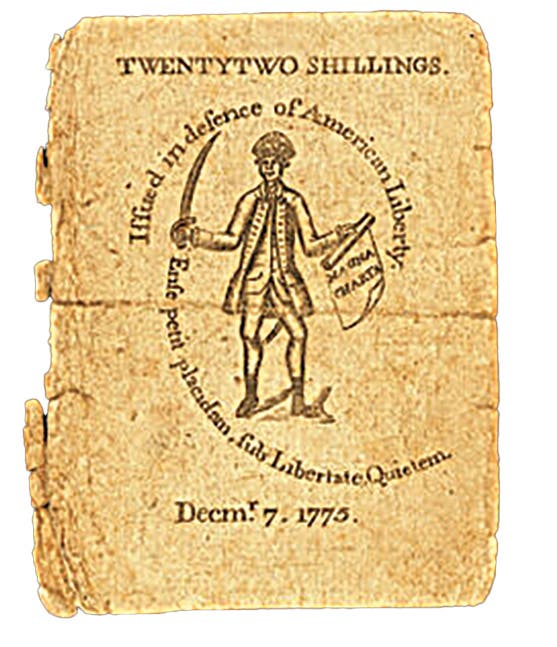More inscribed Civil War notes
By Mark Hotz Last month, I wrote about some inscribed currency from the Civil War, and the response was very positive, so I thought I would continue with more offerings….
By Mark Hotz
Last month, I wrote about some inscribed currency from the Civil War, and the response was very positive, so I thought I would continue with more offerings. I have been looking for interesting Civil War-inscribed items for years, and where better than to present them to the collecting public than in the pages of Bank Note Reporter.
Among my holdings of these notes is a Confederate $1 note of the issue of June 2, 1862 (T-44). On the back, the following is inscribed:
“Received in a letter from/brother George while on board/the gun-boat Nansemond at/ Wilmington N.C./Fred P. Vinton/Boston Decr. 20, ’63.”
The U.S.S. Nansemond was a six-gun side-wheel steamer built in 1862. It was originally named the James Freborn, but when Lt. R.H. Lamson received command on June 30, 1863, it was renamed the Nansemond in honor of Lamson’s achievements on the Nansemond River that runs from Newport News to Suffolk, Virginia. The Nansemond took up blockade duty off the North Carolina coast, and in October 1863, it chased down and destroyed the blockade runner Douro near New Inlet, N.C.
On Nov. 5, 1863, the Nansemond captured the Confederate blockade runner Margaret and Jessie after a prolonged chase off Myrtle Beach, S.C. The Margaret and Jessie was a side-wheel steamer that had been built in 1858 in Scotland and named the Douglas. She was purchased and renamed by Confederate interests in 1862 and began an illustrious career as a blockade runner, making eight successful runs through the blockade in just nine months. It was on her ninth attempt to enter Wilmington, N.C., that the Nansemond captured her.
Lamson took the Nansemond to Baltimore for repairs. The Margaret and Jessie was renamed the Gettysburg and became the swiftest vessel in the Union fleet, capable of 16 knots. Lamson was given command of the Gettysburg and the Nansemond was taken over by Acting Master J.H. Porter.
On June 21, 1864, Nansemond unloaded Union troops at New Inlet, N.C. as part of an expedition to cut the Wilmington and Weldon Railroad. It is worth mentioning that Lt. (later Capt.) Lamson was one of the most successful flotilla captains during the Civil War. No less than three U.S. warships were later named in his honor.
Fred P. Vinton, whose brother George served on the Nansemond and sent the souvenir Confederate dollar note as a Christmas gift, was an portrait artist who lived in Boston. His portrait work was well known between 1870 and 1900, and his 1884 portrait of Charles Devens, the attorney general in the administration of President Rutherford B. Hayes, was exhibited at the Trans-Mississippi International Exposition in Omaha in 1898.
Next is a remainder State of Georgia 50-cent note, issue date Jan. 1, 1864, Criswell No. 31A. On the back is a nice cursive inscription as follows:
“5 Million of this kind of money was taken at the State House at Milledgeville in the State of Georgia and this was given to Lieut. F. Heimer by Captain E. P. Doyle who again presented it to his friend H. Roterman [?]. The Scouts of Shermans Army entered the Capital Ga. Milledgeville on the 23st (sic) Nov. 1864”
I was able to research Lt. Francis Heimer. He enlisted in Company E, 144th New York Volunteer Infantry as orderly sergeant on Sept. 30, 1862. He was promoted second lieutenant on Feb. 7, 1863, and then to first lieutenant on July 4, 1864, and was given command of Company C. He was discharged on June 25, 1865. I have been unable to research Capt. Doyle because there seem to be so many by that last name.
An uncut strip of three 10-cent notes of the county of Nottaway, Va., with issue date of June 5, 1862, came my way a few years back. These were unissued remainders, but bore a simple but telling inscription on the reverse, to wit:
“Captured at Nottoway C.H. April 5th, 1865 by Wm. H. Spellen”
As most of you know, April 5, 1865 was just a few days before the surrender of the Army of Northern Virginia at Appomattox Court House, Va., on April 9. So these notes were captured at the very tail end of the war.
I did some research and located William H. Spellen as a member of the 14th New York Cavalry Regiment. Nottoway Court House is located on U.S. Route 460 between Crewe and Blackstone, Va. The courthouse building was erected in 1843 in the Roman Revival style. It appears today exactly as it did during the Civil War.
Readers may address questions or comments about this article to Mark Hotz directly by email at markbhotz@aol.com.
This article was originally printed in Bank Note Reporter. >> Subscribe today.
More Collecting Resources
• Order the Standard Catalog of World Paper Money, General Issues to learn about circulating paper money from 14th century China to the mid 20th century.
• Are you a U.S. coin collector? Check out the 2018 U.S. Coin Digest for the most recent coin prices.








